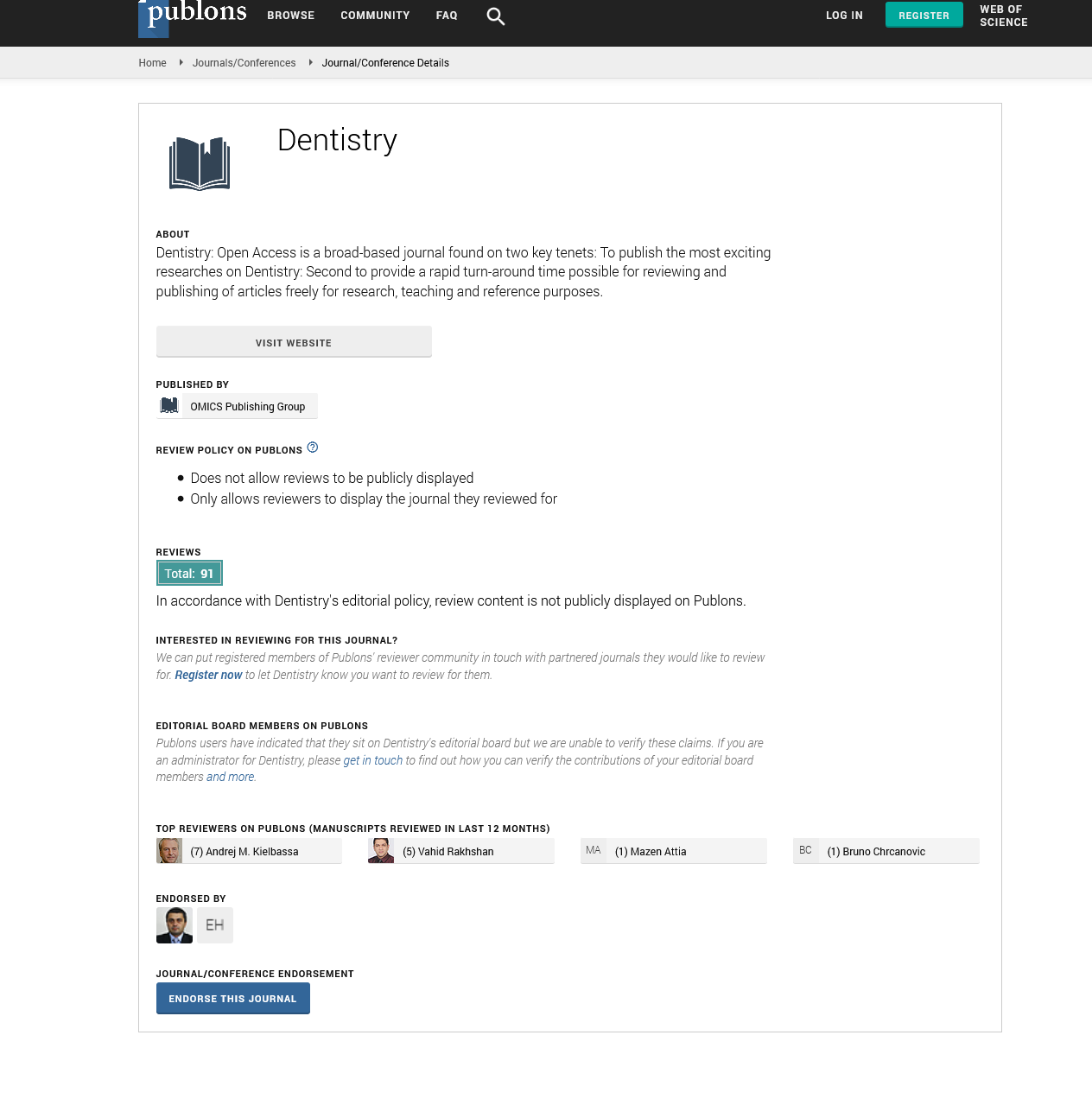Citations : 2345
Dentistry received 2345 citations as per Google Scholar report
Indexed In
- Genamics JournalSeek
- JournalTOCs
- CiteFactor
- Ulrich's Periodicals Directory
- RefSeek
- Hamdard University
- EBSCO A-Z
- Directory of Abstract Indexing for Journals
- OCLC- WorldCat
- Publons
- Geneva Foundation for Medical Education and Research
- Euro Pub
- Google Scholar
Useful Links
Share This Page
Journal Flyer

Open Access Journals
- Agri and Aquaculture
- Biochemistry
- Bioinformatics & Systems Biology
- Business & Management
- Chemistry
- Clinical Sciences
- Engineering
- Food & Nutrition
- General Science
- Genetics & Molecular Biology
- Immunology & Microbiology
- Medical Sciences
- Neuroscience & Psychology
- Nursing & Health Care
- Pharmaceutical Sciences
Perspective - (2025) Volume 15, Issue 1
Genetic and Environmental Influences on Early Dental Alignment
Hesham Youssef*Received: 25-Feb-2025, Manuscript No. DCR-25-28559; Editor assigned: 27-Feb-2025, Pre QC No. DCR-25-28559 (PQ); Reviewed: 13-Mar-2025, QC No. DCR-25-28559; Revised: 20-Mar-2025, Manuscript No. DCR-25-28559 (R); Published: 27-Mar-2025, DOI: 10.35248/2329-9088.25.15.723
Description
Malocclusion in primary dentition is a common dental issue that may lead to functional and aesthetic concerns if not addressed in time. Understanding its prevalence and associated risk factors is essential for early intervention and preventive strategies. This article explores the frequency of malocclusion in primary teeth and the contributing factors that may influence its development.
Prevalence of primary dentition malocclusion
The occurrence of malocclusion in primary dentition varies across different populations and age groups. Studies have reported that a significant proportion of children exhibit some form of malocclusion during early childhood. The most frequently observed types include anterior open bite, posterior crossbite, increased overjet and crowding.
Research indicates that the prevalence of malocclusion in the primary dentition ranges between 30% and 80%, depending on factors such as genetic predisposition, environmental influences and oral habits. Regional differences also contribute to the variation in prevalence, as dietary habits, feeding practices and cultural norms impact dental development.
Risk indicators of primary dentition malocclusion
Several factors contribute to the development of malocclusion in young children. These include genetic predisposition, oral habits, breathing patterns, premature loss of primary teeth and feeding practices.
Genetic factors
Genetic inheritance plays a major role in craniofacial growth and dental arch formation. Children with a family history of malocclusion are more likely to develop similar conditions. Hereditary influences may affect jaw size, tooth size and alignment, leading to conditions such as crowding, spacing and abnormal bite relationships.
Oral habits
Non-nutritive sucking habits, such as thumb-sucking, pacifier use and prolonged bottle-feeding, are strongly associated with malocclusion in the primary dentition. These habits exert pressure on the developing dental arches and contribute to conditions such as anterior open bite, excessive overjet and posterior crossbite. The intensity, frequency and duration of these habits influence the severity of dental changes.
Mouth breathing
Breathing through the mouth instead of the nose can affect craniofacial growth and dental alignment. Chronic mouth breathing is often linked to conditions such as narrow maxillary arches, increased overjet and open bite. It may result from nasal obstructions due to allergies, enlarged adenoids, or other airwayrelated issues.
Premature loss of primary teeth
Early loss of primary teeth due to dental caries or trauma can lead to space loss and subsequent malalignment of permanent teeth. When a primary tooth is lost before its natural exfoliation time, the adjacent teeth may drift into the empty space, causing crowding and improper occlusion in the developing dentition.
Feeding practices
Breastfeeding has been associated with a lower risk of developing malocclusion compared to bottle-feeding. Studies suggest that exclusive breastfeeding for the first six months supports proper jaw development and muscle function, reducing the likelihood of malocclusion. Bottle-feeding and the use of soft diets may contribute to weaker orofacial musculature, leading to improper dental arch development.
Abnormal swallowing patterns
Improper tongue posture and swallowing patterns can influence dental alignment. Tongue thrusting, where the tongue pushes against the front teeth during swallowing, may contribute to open bite and increased overjet. Early identification of these patterns allows for intervention through myofunctional therapy.
Clinical implications and early intervention
Identifying malocclusion in the primary dentition is essential for preventing long-term complications. Early dental visits allow for the assessment of risk factors and the implementation of preventive measures. Pediatric dentists can guide parents on proper oral habits, diet and myofunctional exercises to support healthy dental development.
Orthodontic evaluation during the primary dentition phase helps determine whether interceptive treatment is necessary. In some cases, simple habit-breaking appliances or space maintainers can prevent the progression of malocclusion. When early intervention is provided, the need for complex orthodontic treatment in the permanent dentition may be reduced.
Citation: Youssef H (2025). Genetic and Environmental Influences on Early Dental Alignment. J Dentistry. 15:723.
Copyright: © 2025 Youssef H. This is an open-access article distributed under the terms of the Creative Commons Attribution License, which permits unrestricted use, distribution, and reproduction in any medium, provided the original author and source are credited.

